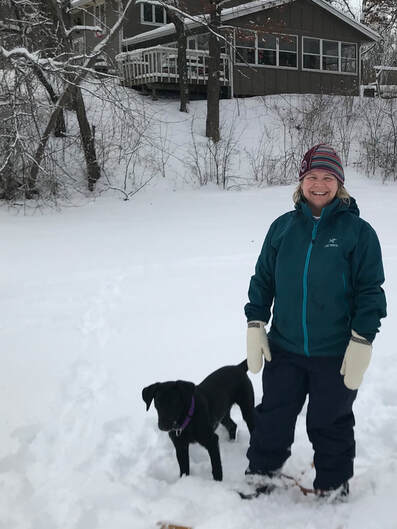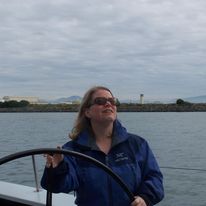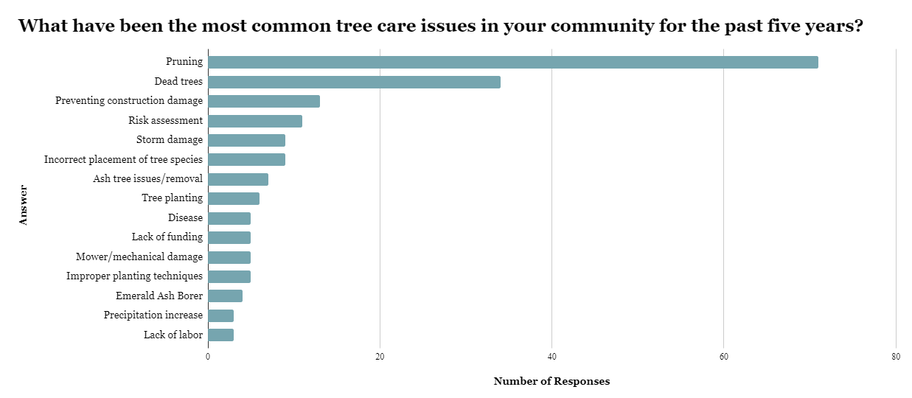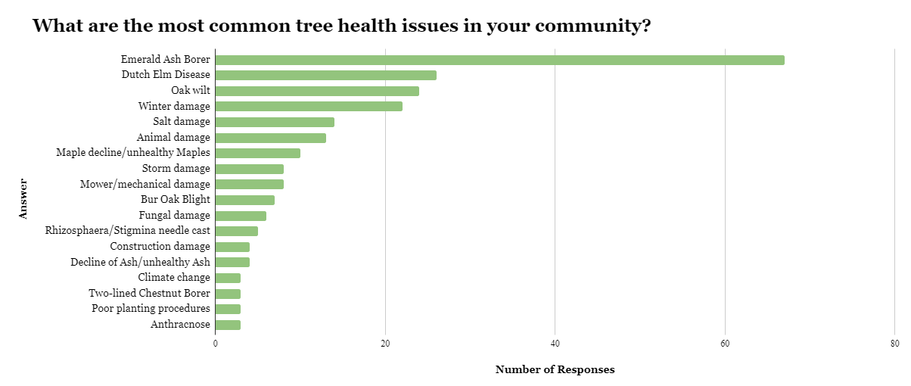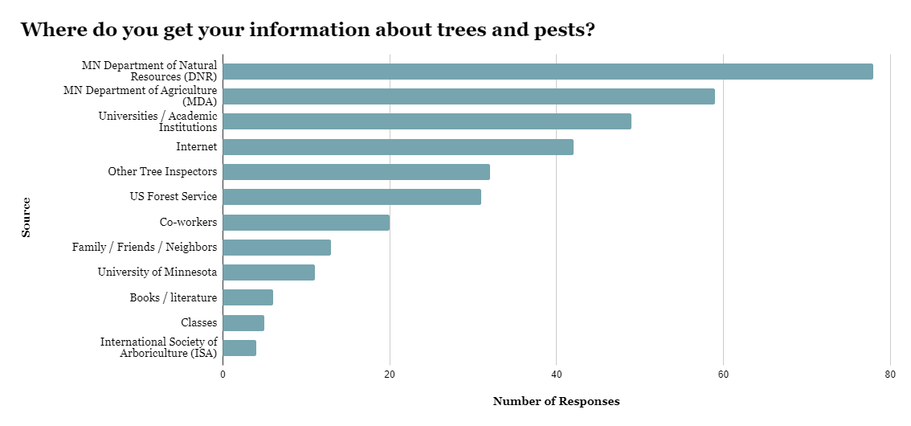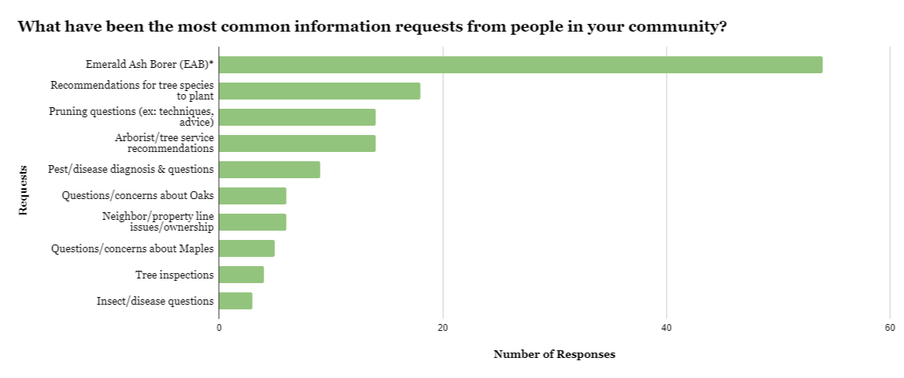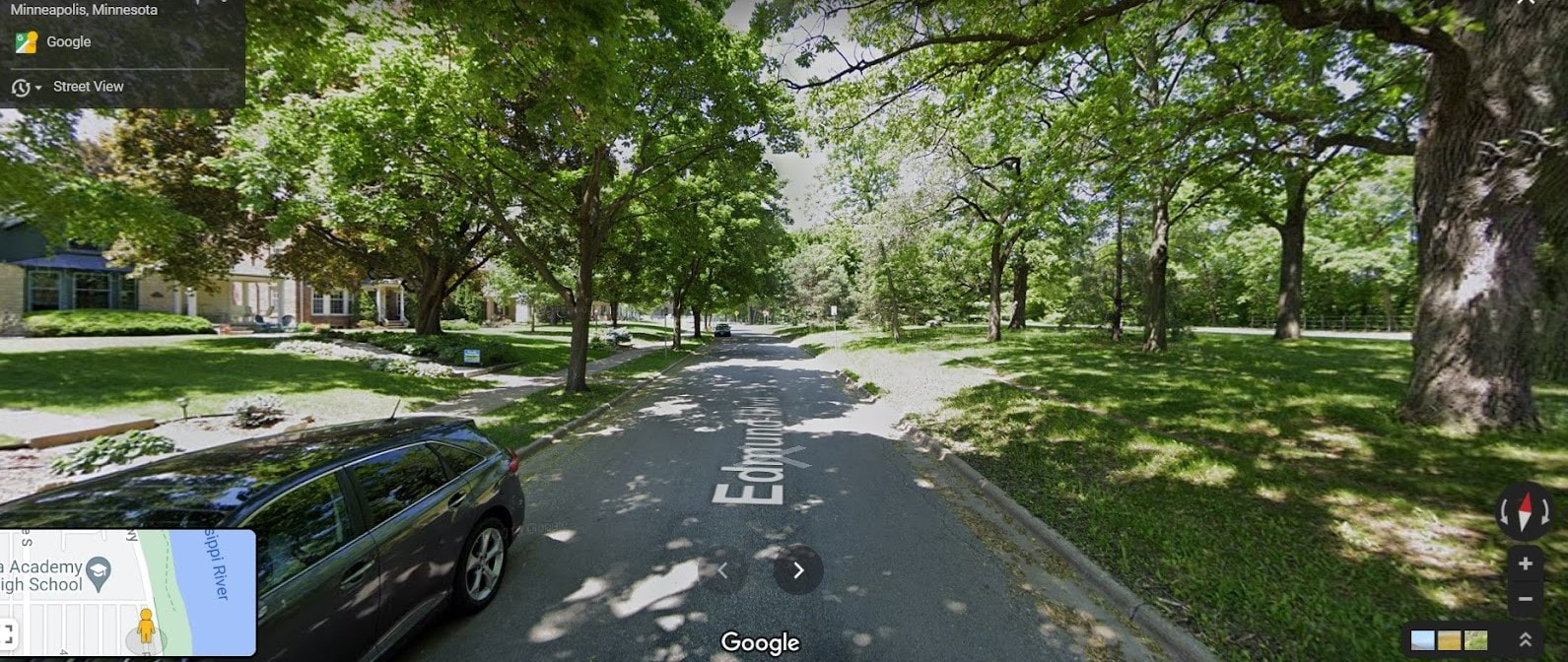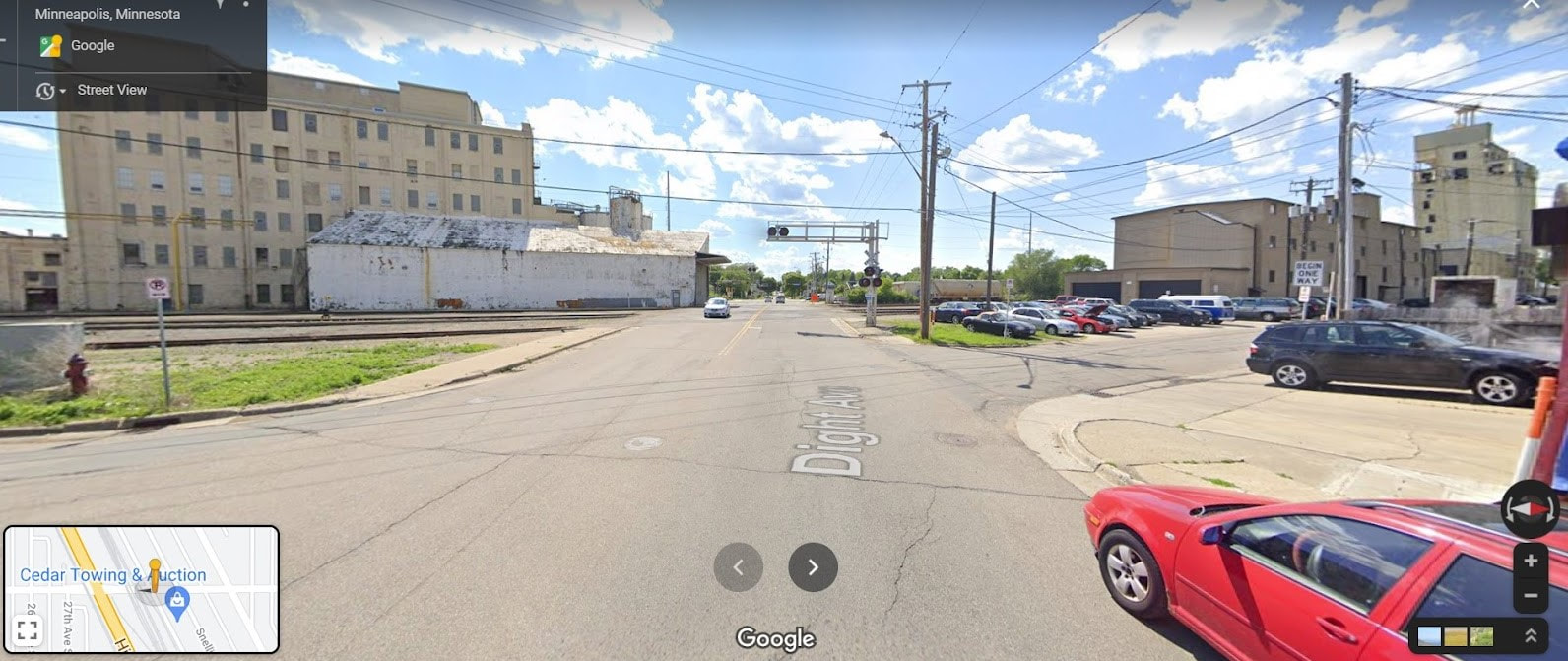CONTENTS
online self-paced tree inspector certification course Available
DNR GRants: 2021 Preparing for EAB grants program
Featured Tree Inspector: gail nozal, Davey Resource Group
2020 MN Tree Inspector needs assessment results
A Preventable Death: Redlining, Tree Canopy, and Urban Heat
By Lillian Prybil
2021 MnSTAC Virtual Forum Recordings To Date
Online tree inspector Certification course
Certify Online via a Self-paced course
Course Fee: $35*
Register for the course: https://learning.umn.edu/search/publicCourseSearchDetails.do?method=load&courseId=23441871
About: The Online Tree Inspector Certification Course and Exam provides all the educational materials and exam in a self-paced online course. Learn from pre-recorded webinars, online published resources, the tree inspector study guide, and practice quizzes. The online course is hosted by the University of Minnesota via the Canvas software platform. Follow the link above to register for the course. Contact Ryan Murphy at [email protected] with any questions.
*Discounts available for students, AmeriCorps, & ConservationCorps.
Register for the course: https://learning.umn.edu/search/publicCourseSearchDetails.do?method=load&courseId=23441871
About: The Online Tree Inspector Certification Course and Exam provides all the educational materials and exam in a self-paced online course. Learn from pre-recorded webinars, online published resources, the tree inspector study guide, and practice quizzes. The online course is hosted by the University of Minnesota via the Canvas software platform. Follow the link above to register for the course. Contact Ryan Murphy at [email protected] with any questions.
*Discounts available for students, AmeriCorps, & ConservationCorps.
2021 PREPARING FOR EAB GRANTS PROGRAM
Apply Now!
2021 Preparing for EAB grants program
The Minnesota Department of Natural Resources welcomes applications from local units of government within Minnesota that assist communities in managing ash for emerald ash borer (EAB) on public land, with $1.6 million available in general fund and Heritage Enhancement Account fund dollars to fund two-year projects. There is no minimum to the dollar amount applicants can request. The maximum amount that will be funded is $100,000.
Eligible Activities
· Public tree inventories
· Developing a management plan that includes an EAB component
· Tree and stump removal and tree replacement on public land
Project Timeline:
Application Available: Monday, July 12, 2021
Application Deadline: Monday, August 9, 2021
Visit the Grant Website for additional details and grant submission documents.
2021 Preparing for EAB grants program
The Minnesota Department of Natural Resources welcomes applications from local units of government within Minnesota that assist communities in managing ash for emerald ash borer (EAB) on public land, with $1.6 million available in general fund and Heritage Enhancement Account fund dollars to fund two-year projects. There is no minimum to the dollar amount applicants can request. The maximum amount that will be funded is $100,000.
Eligible Activities
· Public tree inventories
· Developing a management plan that includes an EAB component
· Tree and stump removal and tree replacement on public land
Project Timeline:
Application Available: Monday, July 12, 2021
Application Deadline: Monday, August 9, 2021
Visit the Grant Website for additional details and grant submission documents.
FEATURED TREE INSPECTOR:
|
|
What is your current professional position?
I'm the area manager of our Davey Resource Group office in Minnesota. I am out doing consulting on a regular basis as well as tree risk assessment and managing. That's pretty typical whether you're a one person operation or a company, you kind of continue to keep working with trees, in addition to other duties, of course. What first got you interested in trees, and when did you realize you could have a career working with trees? I knew about forestry when I was a little kid, actually. My uncle was a forester for the US Fish and Wildlife Service based in Alaska and he had graduated from the College of Forestry back in the 1960s. So, I was aware of forestry, but more in the traditional sense and I knew that I did not want to live in a rural setting. I definitely wanted to be in an urban setting. For me, it was not just solely about trees, it was really about connecting trees and people, so having that connection to make a difference was really important to me. |
|
What is your educational background?
I changed my major several times in college before I really figured it out. I knew I wanted to work outdoors, but the job market in the early 1990s was pretty tough. Ultimately, I ended up transferring from UMD down to the U of M and getting into urban forestry. I started at the same time as Gary Johnson started at the U. |
|
I finished my undergraduate and then took about a year off and worked for the Tree Trust as an intern. Then I returned to graduate school, and I designed a program that included a Masters of Science in forestry with an emphasis in education. I focused on computer based learning and developed a computer program that connected the outdoors and technology, providing another avenue of learning for those kids who enjoy both the outdoors and technology. I also designed the first website for Tree Trust with all html coding at that time, because there was no WordPress.
|
|
What makes online education impactful or what features of online or digital education around trees works for folks?
I know that a lot of us that are doing urban forestry and regular forestry are very driven towards the outdoors, but I see online education as another way to engage people and promote learning. The traditional textbooks are a source we all learn from. However, there's just so many more options now that are available and I think that, especially for the visual learners, having some type of online presence with videos is more impactful than simply having to read the old textbooks. You certainly learn things from reading books, but I've always been a hands-on and visual learner, so online education was definitely more stimulating to me than simply just memorizing formulas. When did you first become a tree inspector? In 1994, when I first became a tree inspector, there were a lot of job opportunities for seasonal tree inspectors with cities. That was a typical path, so I got a license and my first job was with the City of Plymouth as a seasonal tree inspector. That was a fun job and I had previously spent summers working at summer camps with kids, so it definitely felt like it was a needed step that I had to make in urban forestry. I liked it, but just looking at trees every day and inspecting for Dutch elm disease and oak wilt made me want some more variety. |
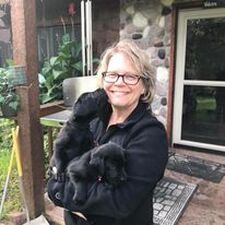
Are the issues different today than in the past?
I don't think so. There continues to be urban forest impacts from different types of shade tree disease, insects, and disease problems. There's not as much Dutch Elm disease, of course, but for most cities there's still oak wilt. I’m still doing a lot of oak wilt inspection for some municipalities, and I’m doing a lot of public education on a contract basis for cities too. That's really where the tree inspector program comes in, not just from the enforcement side which is needed for a lot of communities, but it's really that public education side of things. For example, letting people know this is what a red oak looks like or these are the challenges that you can have with oak wilt and with EAB, etc. People are still asking how to identify an ash tree and whether it is susceptible to emerald ash borer. It's amazing how we might think that everybody knows about EAB, but they don't. It's shocking. They still don't know how to ID a tree, what the susceptibility issues are in their community, or the insect pressure. Do you see that the landscape has changed in terms of cities and tree inspectors? Yes, significantly. I think there's probably only a few cities that are still hiring on a seasonal basis, and I think that largely changed when some of the model ordinances changed. There wasn't a requirement for many cities to have to maintain a shade tree disease program. There's still some cities that have maintained it, but many have let it kind of go by the wayside. You say that they were required to have an ordinance, was that state based? Yes, which has changed. There was a statute written in the 1970s that the cities had to have a shade tree disease program and inspect for Dutch elm disease, and oak wilt was added to that in the 80s. Probably by the 2000s that really changed, and it was more a voluntary basis to maintain those programs. With the other professional certifications you have, what inspires you to keep the tree inspector certification? I'm an ISA Board Certified Master Arborist, Municipal Specialist, and have the Tree Risk Assessment Qualification (TRAQ). I'm still doing tree inspecting for cities, so even though I've got those other international credentials, I still think it's important to support the state tree inspector program. I think there's value in showing that the state is still providing that education, and it's a great way to get into the field as well. Currently, the certification curriculum is primarily Dutch elm disease, oak wilt, emerald ash borer, and best planting practices. Are there things that you think would be beneficial for the program to include in the base certification? When I think of basic tree care, I think about basic insect and disease diagnostics. I also think watering and mulching probably get just as many questions as how to plant correctly, so those are things that are important to talk to residents about. The first thing is to just get a tree started off right, but it doesn't stop at just putting it in the ground and walking away. Even some basic understanding of pruning, especially with all the elms, is important too. I think there's going to be a lot of opportunities for even more planting because of potential federal funds that will go into tree planting, like the 1 Trillion Trees Campaign. It is great to plant trees and get them in the ground correctly, but proper care is super important as well. What is Women in Arboriculture and are there ways for folks to get involved if they’re interested? The Women in Arboriculture program started as an ISA initiative primarily focused on creating an opportunity for women tree climbers to network. It has since expanded over the years to just be a more general program for women in arboriculture. It started at the national level and continues to be a group that convenes at the ISA conference each year, whether it's online or in person. There's been some other groups that have formed from that. Rebecca Johnson hosts a monthly Women in Arboriculture networking Zoom meeting that includes people from all over the country and Canada. They get together and talk about challenges that they face in the job which creates opportunities to support each other. That continues on a national level currently, and they meet the second Tuesday of every month. That's open to everybody, it doesn't certainly need to be just women. Locally we've done some things as well. Through the Minnesota Society of Arboriculture we hosted a two day Women in Arboriculture conference which was held in 2014 or 2015. There's also been some further efforts with MSA. We hosted a breakfast, and I’d definitely like to see some more opportunities locally to try and help connect women. While it's great to have national opportunities, it is certainly great to do some things locally as well. I would see that there's going to be even more things happening in the future as we try to increase more opportunities for women in the industry. Are there any specific websites or social media that you could point folks to? If you Google Women in Arboriculture you'll come up with a main page with the ISA: https://www.isa-arbor.com/Newsroom/celebrating-women-in-arboriculture-2021. I would suggest checking out the Women in Arboriculture Zoom session hosted by Rebecca Johnson as well. She can be found on LinkedIn and the link to those sessions is: https://www.eventbrite.com/e/women-in-arboriculture-virtual-chat-tickets-116950007621. Here are some links to different Facebook groups: https://www.facebook.com/groups/womeintreecare https://www.facebook.com/groups/womeninwood https://www.facebook.com/groups/womenintrees https://www.facebook.com/groups/2266606696895883 How are you currently involved with the Minnesota Shade Tree Advisory Committee (MnSTAC)? First off, I got involved with MnSTAC basically right after college. It was a way to connect and meet people in the industry, and connect to some job opportunities. I've stayed involved with MnSTAC in different capacities over the years. Currently, I'm on the board representing the commercial sector, and I'm also chairing the outreach committee. Having that passion of wanting to connect people and provide resources has reinvigorated the outreach committee. We started meeting late last year and probably have about nine people that meet every other month. We recently completed a survey to find out what some of the needs are for communities in the metro as well as greater Minnesota, and we are working on putting together some articles that will be put up on the MnSTAC website. MnSTAC has evolved since the 70s from an advocacy organization for the public to more of a professionals group, so connecting with the public and finding out what the needs of the community are is something we have to circle back to. |
2020 Tree Inspector Needs assessment results
|
Every five years, the University of Minnesota conducts a needs assessment of the MN Tree Inspector Certification Program by surveying current Tree Inspectors about what's happening in their communities. The goal of this needs assessment is to ensure educational offerings are inline with the issues that exist within Minnesota's community forests and those working to manage them. The current needs assessment survey was conducted during 2019 and 2020. Surveys were distributed at Tree Inspector workshops and online via the Tree Inspector email list.
|
Tree inspectors around the state of Minnesota were asked to provide information regarding tree care issues that have been the most common over the past five years. Respondents identified pruning as the number one tree care issue. Pruning responses consisted of issues involving the timing of pruning, incorrect pruning technique, proper training, and reactive pruning. The second most popular response from this survey was the issue of dead trees including identifying, removing, and replacing dead trees. Other tree care issues that Tree Inspectors identified are preventing construction damage, risk assessment, storm damage, and the incorrect placement for certain tree species.
Survey participants were asked about the most common tree health issues present in their community. The number one answer was emerald ash borer with 67 respondents expressing concern about the beetle. Dutch elm disease was also a large concern for the health of trees all around Minnesota. Other health concerns included oak wilt, maple tree decline, bur oak blight, as well as damage from winter, salt, animals, mowers, and storms.

In order to discover which tree species are doing well around Minnesota, respondents were asked to identify species in their area that have the lowest mortality rate and are in the best condition. The tree species that was most frequently listed as doing well was oak, specifically bur oak, swamp white oak, white oak, and red oak. The second healthiest tree was maple which included responses regarding the silver maple, red maple, freeman maple, and sugar maple. Hackberry, elm, locust, pine, linden, ash, and Kentucky coffeetree were also high on the list.
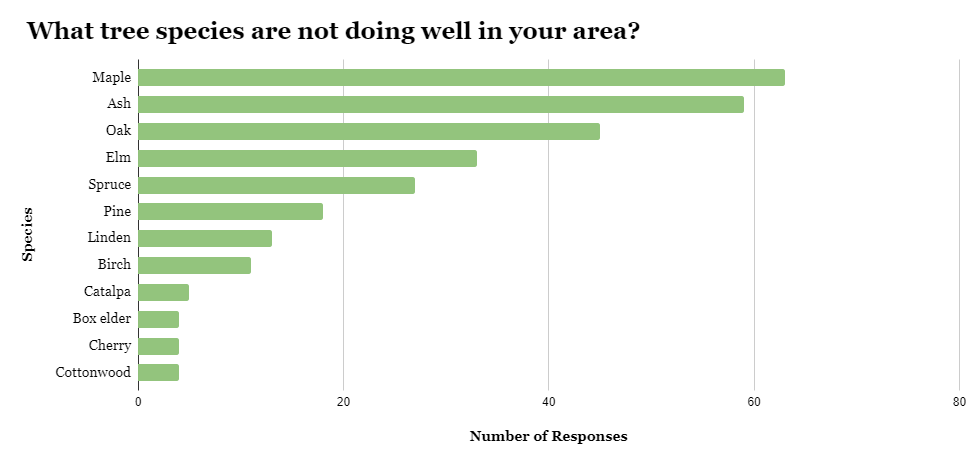
Respondents were also asked about tree species in their area that are not doing well. Maple was reported as having the highest mortality rate and poorest conditions. Specific species of maple that were mentioned include sugar maple, Norway maple, red maple, and Autumn Blaze maple. Ash, oak, elm, and spruce were also frequently reported as not doing well by respondents. It is interesting that this set of top responses nearly mirrors that of the previous question. More work is needed to understand if there is a difference in tree performance based on location or whether similarities are the result of these tree genera being ubiquitous in the landscape and accounting for a high percentage of MN community forests.
Minnesota Tree Inspectors were asked to provide the top sources they use to gain information regarding trees and pests. Seventy-eight respondents said the Minnesota DNR was their source for information, making it the most popular response. Many respondents also use the MN Department of Agriculture, universities, the internet, other tree inspectors, and the US Forest Service for tree and pest information. Co-workers, family and friends, the University of Minnesota, books, classes, and the ISA also proved to be popular places to find information.
Respondents were asked what the most common information requests have been from people in their community. The data shows Emerald ash borer as the most popular answer followed by recommendations for which tree species to plant, pruning questions, and arborist recommendations. EAB responses included requests for management options, treatment options, diagnosis of trees, and questions regarding the symptoms of EAB. Many responses involved requests about the health of trees including questions about fungus, needle drop, insects, and disease. Other responses were concerned with ownership confusion and issues, questions about planting and caring for a tree, and tree removal techniques.
A Preventable Death: Redlining, Tree Canopy, and Urban Heat
By: Lillian Prybil
|
This article will provide an overview of complications resulting from a historical practice called “redlining”. In the 1930s, the Homeowners Loan Corporation (HOLC) created and distributed maps of 239 cities in the US which categorized investment risk by neighborhoods based upon racist ideologies (Aaronson, cited in Hoffman et al.). Due to the guidance of these HOLC maps, banks and insurance companies then either refused or raised rates on loans or homeowners insurance for residents in neighborhoods designated with a red line on the map. People living in redlined areas experienced a great reduction in personal access to credit, and therefore, these neighborhoods suffered from a lack of investment. In redlined areas, homes lost value, and personal credit scores decreased more than similar neighborhoods in cities that did not receive HOLC maps. The legacy of these maps lives on in many ways, and redlined areas are still home to more low-income individuals and People of Color than neighborhoods which received positive HOLC ratings (Mitchell, cited in Hoffman et al.).
HOLC zoning has also been correlated with urban tree canopy density. Hoffman investigated the correlation between HOLC zones and current impervious surface and tree canopy cover and found that the redlined areas still have significantly less canopy cover and more impervious surfaces (1). There are many likely reasons for this observation. Lower land values in redlined areas likely incentivized future development of large buildings, infrastructure like highways, and other impervious surfaces (1). Additionally, neighborhoods with wealthier residents had the resources to prioritize “beautification” and air purification investments like planting urban forests. The disparities in land cover type between HOLC map zones is relevant because land cover type influences urban heat patterns. One of the many benefits of high functioning urban forests is their ability to prevent or counteract negative effects of urban heat islands (UHI). Urban heat islands are a phenomenon of urbanization where temperatures in urban areas are relatively higher than in rural areas (2). Generally speaking, UHI effect is caused by changes in the built and natural environment found only in urban areas (2). High local temperatures in urban areas can be attributed to an increase in impervious surfaces like concrete (Li, cited in Hoffman et al.), whereas urban green areas like forests and lakes are associated with lower temperatures (1). The strength of urban heat island effect varies greatly from neighborhood to neighborhood based on land cover characteristics. |
Tree canopy density varies greatly between neighborhoods of the same city. Left:
Edmund Blvd & E 23rd St - Best Holc Rating. Right: E 35th St & Dight Ave Mpls) - Redlined
Edmund Blvd & E 23rd St - Best Holc Rating. Right: E 35th St & Dight Ave Mpls) - Redlined
|
Additionally, limited canopy cover increases the UHI effects like extreme heat (1), which comes with health risks. These health risks include heat-related illnesses like heat stroke, heat exhaustion, and in extreme cases result in death (3). UHI effects tend to impact areas with lower tree canopy strongest. As noted earlier, redlined areas have significantly lower amounts of tree canopy cover and are inhabited by more People of Color. This puts People of Color at a higher risk for death from extreme heat. A preventable death.
Tree canopy can also influence community feelings of safety and wellbeing. A study conducted in Norway found that increased tree canopy in a neighborhood had a significant positive correlation with the perceived safety of a neighborhood (4). Black, Indigenous, and People of Color (BIPOC) continue to be killed by prejudiced, fearful, violent, and inexperienced law enforcement officers. Law enforcement officers’ assessments of neighborhood safety are likely colored by the amount of tree canopy in an area, which could influence their actions. For neighborhoods lacking tree canopy, outsiders and residents alike will have inaccurate negative perceptions about the safety of their community. Understandably, these negative perceptions can impact the well-being of residents. Well-supported correlations link BIPOC populations to previous redlining areas, redlining to decreased tree canopy, decreased tree canopy to perceived safety, decreased tree canopy to stronger UHI effect, and stronger UHI effect to negative health outcomes. These correlations suddenly reveal some ways that our urban forest distribution has been influenced by and perpetuates racist practices in US history. These practices influence the daily lives and health of people living and working in urban areas. The negative health effects from Urban Heat Islands are a human welfare issue. These deaths can and should be prevented. In lieu of a simple action that will solve this whole problem, I ask you to do the following:
References
Further Reading: https://www.nytimes.com/2021/07/02/climate/trees-cities-heat-waves.html https://www.americanforests.org/our-work/tree-equity-score/ https://www.nytimes.com/interactive/2021/06/30/opinion/environmental-inequity-trees-critical-infrastructure.html https://doi.org/10.1016/j.atmosenv.2020.117739 |
2021 Virtual MnSTAC Forum Recordings
Each month, the Minnesota Shade Tree Advisory Committee (MnSTAC) in collaboration with the University of Minnesota Urban Forestry Research and Outreach (UFor) lab hosts a monthly forum on topics of interest to the MN urban forestry community. Below you can find the most recent recordings of the 2021 forum series to date. To stay current with upcoming forums and other community forestry news, please visit www.mnstac.org and subscribe to the weekly newsletter.
April
Tree Preservation and Construction: Can a Municipal Ordinance Successfully Protect Trees?
Trees provide significant benefits to human society. Urban trees, however, are often at odds with their environment due to injury, disturbance, inadequate planting space, or lack of care. Construction, in particular, can present a major challenge; studies have found that unchecked construction activities can negatively impact the condition of tree trunks and root systems - which can ultimately lead to early tree death. To safeguard the benefits that trees provide, communities have begun to enact tree preservation ordinances that provide guidelines, backed by policy, for tree preservation during construction. This presentation provides an example of a municipality that has established a comprehensive tree preservation ordinance and the results of a study that evaluated its effectiveness for protecting trees on private, residential properties.
Speaker: Kaitlyn Pike, University of British Columbia in Vancouver, Canada
Tree Preservation and Construction: Can a Municipal Ordinance Successfully Protect Trees?
Trees provide significant benefits to human society. Urban trees, however, are often at odds with their environment due to injury, disturbance, inadequate planting space, or lack of care. Construction, in particular, can present a major challenge; studies have found that unchecked construction activities can negatively impact the condition of tree trunks and root systems - which can ultimately lead to early tree death. To safeguard the benefits that trees provide, communities have begun to enact tree preservation ordinances that provide guidelines, backed by policy, for tree preservation during construction. This presentation provides an example of a municipality that has established a comprehensive tree preservation ordinance and the results of a study that evaluated its effectiveness for protecting trees on private, residential properties.
Speaker: Kaitlyn Pike, University of British Columbia in Vancouver, Canada
May
Relationships between consultant discipline and specified tree diversity
Relationships between consultant discipline and specified tree diversity: A case study of two Iowa (USA) communities. Managing taxonomic diversity in urban forests is one means of mitigating threats imposed by biotic and abiotic threats that could result in tree loss. Many non-arboriculture professional consultants can specify trees for construction projects and those consultants may vary in their training regarding plant material use and site assessment. We used publicly available site plans submitted for zoning permitting to assess relationships between consultant type, tree diversity, and tree selections in two Iowa communities. We found strong relationships of site size and tree diversity and weak evidence of consultant-specific diversity outcomes at the site-level but stronger differences in tree palettes across a city or between cities, depending on the consultant type.
Speaker: Grant L. Thompson, PhD, PLA Assistant Professor - Iowa State University
Relationships between consultant discipline and specified tree diversity
Relationships between consultant discipline and specified tree diversity: A case study of two Iowa (USA) communities. Managing taxonomic diversity in urban forests is one means of mitigating threats imposed by biotic and abiotic threats that could result in tree loss. Many non-arboriculture professional consultants can specify trees for construction projects and those consultants may vary in their training regarding plant material use and site assessment. We used publicly available site plans submitted for zoning permitting to assess relationships between consultant type, tree diversity, and tree selections in two Iowa communities. We found strong relationships of site size and tree diversity and weak evidence of consultant-specific diversity outcomes at the site-level but stronger differences in tree palettes across a city or between cities, depending on the consultant type.
Speaker: Grant L. Thompson, PhD, PLA Assistant Professor - Iowa State University
Open access journal article from this talk: https://www.sciencedirect.com/science...
June
Granting Minnesota's Urban Forests
When operating an urban forestry program there is always more that could or should be done. Usually time and budget are the major hurdles to accomplishing more with your urban forestry program. In this presentation Ryan Gustafson of the Davey Resource Group will do an overview of the local, state, and national level grant programs that can be used for urban forestry projects. Ryan will also go over some other funding sources for other education opportunities and possible upcoming grant programs.
Speaker: Ryan Gustafson, Davey Resource Group, Inc.
Granting Minnesota's Urban Forests
When operating an urban forestry program there is always more that could or should be done. Usually time and budget are the major hurdles to accomplishing more with your urban forestry program. In this presentation Ryan Gustafson of the Davey Resource Group will do an overview of the local, state, and national level grant programs that can be used for urban forestry projects. Ryan will also go over some other funding sources for other education opportunities and possible upcoming grant programs.
Speaker: Ryan Gustafson, Davey Resource Group, Inc.
Links mentioned in this talk:
Minnesota Society of Arboriculture http://msa-live.org/
Minnesota Watershed Districts https://www.mnwatershed.org/
Tree Trust Green Futures https://treetrust.org/non-profit/comm...
Minnesota Community Forestry Corps https://www.servetogrow.org/forestry
CPL grants https://www.dnr.state.mn.us/grants/ha...
Vibrant Cities Lab https://www.vibrantcitieslab.com/
Emma Schultz, MN DNR on application strategies https://minnesota.webex.com/recording...
Minnesota Tree Care Advisor Program https://mntca.umn.edu/
Minnesota Society of Arboriculture http://msa-live.org/
Minnesota Watershed Districts https://www.mnwatershed.org/
Tree Trust Green Futures https://treetrust.org/non-profit/comm...
Minnesota Community Forestry Corps https://www.servetogrow.org/forestry
CPL grants https://www.dnr.state.mn.us/grants/ha...
Vibrant Cities Lab https://www.vibrantcitieslab.com/
Emma Schultz, MN DNR on application strategies https://minnesota.webex.com/recording...
Minnesota Tree Care Advisor Program https://mntca.umn.edu/
July
Community Forestry Corps: Service, Inspiration, & Support for Minnesota's Urban & Community Forests
The Community Forestry Corps (CFC) is a new AmeriCorps program launched in Minnesota in 2020 with members providing key support for organizations and communities across Minnesota. During this inaugural season, CFC Members have provided critical services that have allowed communities to assess, respond, and begin to restore their urban forests as threats like emerald ash borer continue to ravage Minnesota. Please join us to learn from their experiences and to have an opportunity to get to know a little more about CFC and how it supports Minnesota's urban and community forestry efforts.
Speakers:
Jacob Geller, City of Warren
Jack Reddan, City of Woodbury
Crystal Rayamajhi, City of Moorhead Public Works
Community Forestry Corps: Service, Inspiration, & Support for Minnesota's Urban & Community Forests
The Community Forestry Corps (CFC) is a new AmeriCorps program launched in Minnesota in 2020 with members providing key support for organizations and communities across Minnesota. During this inaugural season, CFC Members have provided critical services that have allowed communities to assess, respond, and begin to restore their urban forests as threats like emerald ash borer continue to ravage Minnesota. Please join us to learn from their experiences and to have an opportunity to get to know a little more about CFC and how it supports Minnesota's urban and community forestry efforts.
Speakers:
Jacob Geller, City of Warren
Jack Reddan, City of Woodbury
Crystal Rayamajhi, City of Moorhead Public Works
This publication made possible through a grant from the Minnesota Department of Natural Resources and the USDA Forest Service. This institution is an equal opportunity provider.
In accordance with Federal law and U.S. Department of Agriculture (USDA) civil rights regulations and policies, this institution is prohibited from discriminating on the basis of race, color, national origin, sex, age, disability, and reprisal or retaliation for prior civil rights activity. (Not all prohibited bases apply to all programs.)
Persons with disabilities who require alternative means of communication for program information (e.g., Braille, large print, audiotape, American Sign Language, etc.) should contact the responsible State or local Agency that administers the program or USDA’s TARGET Center at (202) 720-2600 (voice and TTY) or contact USDA through the Federal Relay Service at (800) 877-8339. Additionally, program information is also available in languages other than English.
To file a complaint alleging discrimination, complete the USDA Program Discrimination Complaint Form, AD-3027, found online at http://www.ascr.usda.gov/complaint_filing_cust.html , or at any USDA office or write a letter addressed to USDA and provided in the letter all of the information requested in the form. To request a copy of the complaint form, call (866) 632-9992. Submit your completed form or letter to USDA by: (1) mail: U.S. Department of Agriculture, Office of the Assistant Secretary for Civil Rights, 1400 Independence Avenue, SW, Washington, D.C. 20250- 9410; (2) fax: (202) 690-7442; or (3) email: program. [email protected].
This institution is an equal opportunity provider.
In accordance with Federal law and U.S. Department of Agriculture (USDA) civil rights regulations and policies, this institution is prohibited from discriminating on the basis of race, color, national origin, sex, age, disability, and reprisal or retaliation for prior civil rights activity. (Not all prohibited bases apply to all programs.)
Persons with disabilities who require alternative means of communication for program information (e.g., Braille, large print, audiotape, American Sign Language, etc.) should contact the responsible State or local Agency that administers the program or USDA’s TARGET Center at (202) 720-2600 (voice and TTY) or contact USDA through the Federal Relay Service at (800) 877-8339. Additionally, program information is also available in languages other than English.
To file a complaint alleging discrimination, complete the USDA Program Discrimination Complaint Form, AD-3027, found online at http://www.ascr.usda.gov/complaint_filing_cust.html , or at any USDA office or write a letter addressed to USDA and provided in the letter all of the information requested in the form. To request a copy of the complaint form, call (866) 632-9992. Submit your completed form or letter to USDA by: (1) mail: U.S. Department of Agriculture, Office of the Assistant Secretary for Civil Rights, 1400 Independence Avenue, SW, Washington, D.C. 20250- 9410; (2) fax: (202) 690-7442; or (3) email: program. [email protected].
This institution is an equal opportunity provider.

